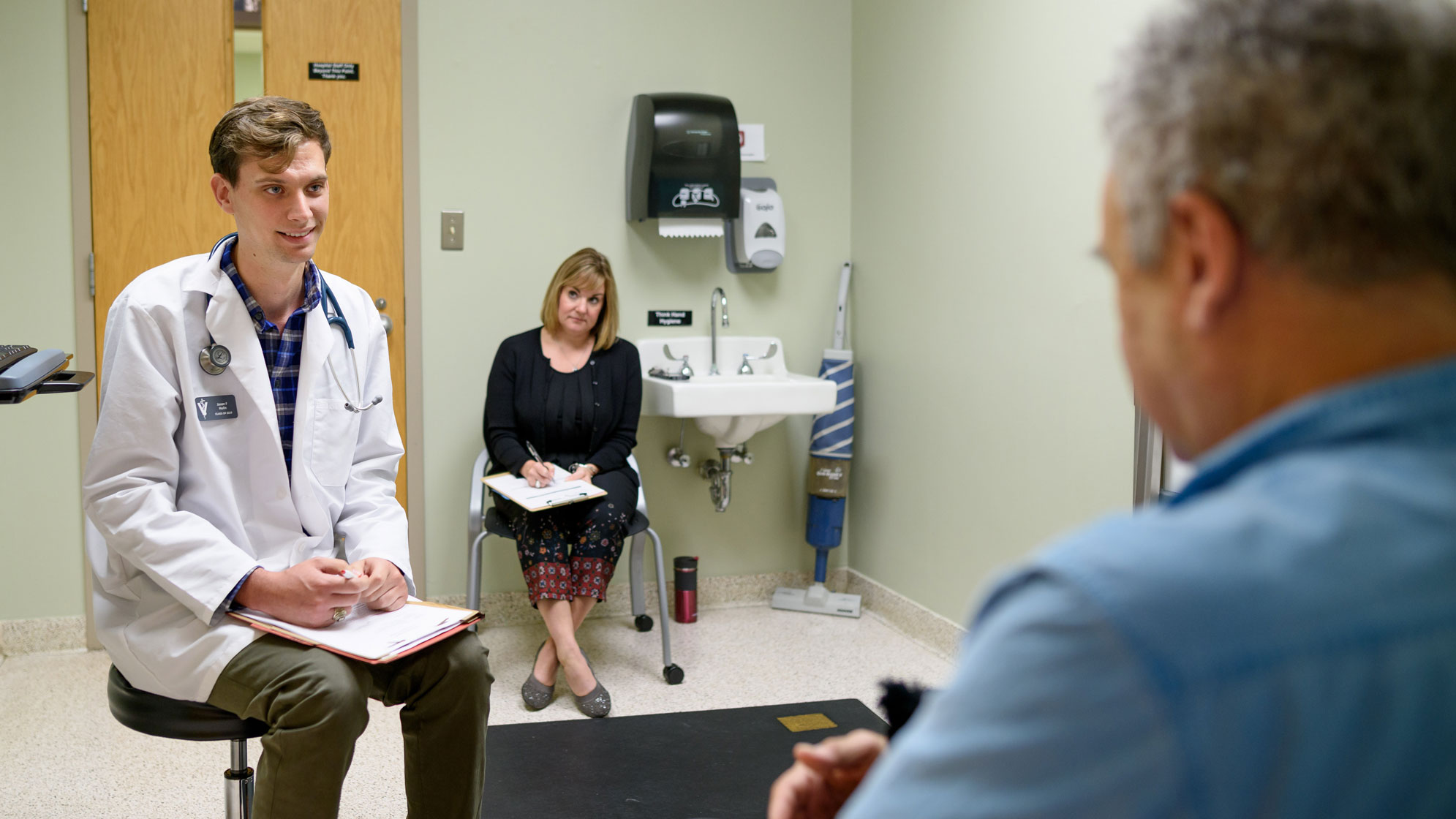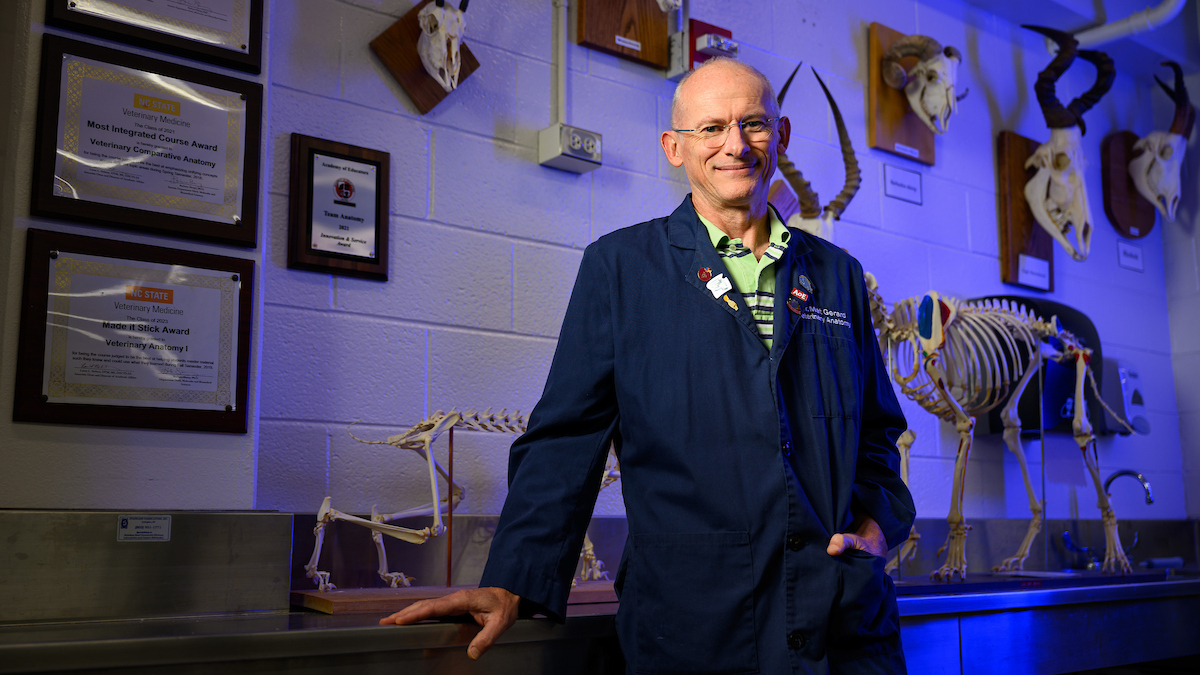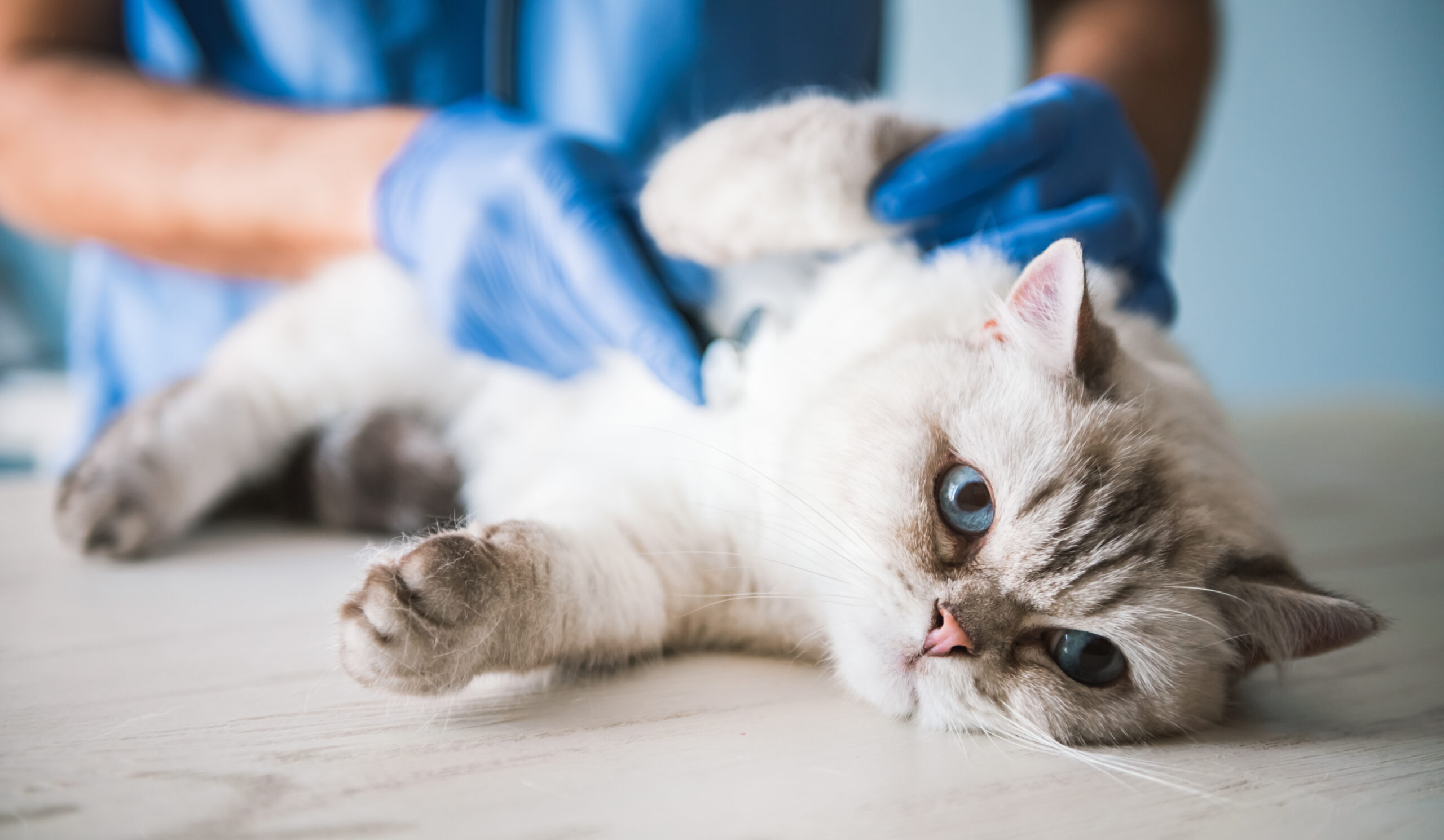Building DVM Skills One Conversation at a Time

Jenna Herrington is in the middle of a talk she’ll have throughout her career and will never get easier.
Her words are direct, but her tone is comforting. After being diagnosed with Lyme disease, Telly, a young dog, is now showing clear signs of kidney failure.
Herrington gives Telly’s owner, Karen, some options. One is more aggressive therapy, but Herrington says that for dogs in Telly’s situation, that heightened therapy is successful about 1 percent of the time.
“That’s why today I think we need to discuss euthanasia as an option,” says Herrington. It’s important that we discuss what you’re comfortable with and what you know about it, and what really is going to be the best option, both for you and him.”
Karen’s body stiffens; her eyes widen and her shoulders slouch. She stops looking at Herrington and glances over at Telly.
“He’s still pretty young. There’s nothing that can be done …. to put him back together?” says Karen as she slowly pets Telly and lets out a deep sigh.
Karen asks if euthanasia is the best option. Herrington says again that she feels it is. Eventually, Karen agrees to the procedure, then asks to have a private moment with Telly. Herrington gets up slowly and asks again if Karen has any questions.
“OK, good,” says a voice from a corner of the examination room. “What do you think went well and what didn’t go as well?”
The Power of Communication
Herrington isn’t a veterinarian — yet. She’s a third-year student at the NC State College of Veterinary Medicine. Karen Butler-Woolford isn’t a real client; she regularly plays a pet owner for the CVM. And that voice from the corner of the room is Peter Cowen, an associate professor of epidemiology and public health at the CVM
Telly isn’t even real. He’s a life-sized stuffed animal.
It is all a simulation, part of the CVM’s Advanced Clinical and Professional Communication class, the culmination of three semesters of communication training over three years for doctor of veterinary medicine students.
In the first two semesters of classes, students study and practice effective communication skills for working with animal owners, colleagues and senior clinicians. They take hard looks at their own communication strengths and weaknesses and talk about what they especially want to work on.
The advanced class ups the ante.
During their third year, students engage in carefully crafted, real-world veterinary simulations of everything from basic check-ups to difficult, often emotional euthanasia cases. The simulations are bolstered by feedback from fellow students and veterinarians in the room, all in preparation for fourth-year clinical rotations when they will have daily, detailed interactions with clients at the NC State Veterinary Hospital.
And they are videotaped. Like a pro pitcher analyzing a fastball, students later watch themselves in the simulations. They listen to what information they give and how they give it. They see if they smile or if they ignore client questions. Fellow students and clinicians give feedback, but students are always able to self-reflect on each simulation performance.
“It doesn’t just help students understand the importance of effective communication, it helps them to better understand their own communication,” said April Kedrowicz, assistant professor of communication who coordinates the pre-clinical communication courses for DVM students. “It’s a really powerful assessment of where they excel and where they have opportunities for development.”
The CVM’s veterinary communication curriculum that is one of the most robust in the country. Kedrowicz arrived at the CVM in 2013, primarily hired to create and lead a structured program for veterinary students. She had previously launched a professional communication program for engineering students at the University of Utah.
The result is an innovative, thorough approach to instilling communication values that apply to the wide range of situations veterinarians face every day. The Class of 2018, graduating this May, will be the first to leave the CVM with a full communications course load.
“I tell them that you never get to a point where you are done developing your communication skills — never,” said Kedrowicz.
The first lesson is tough: There is no such thing as a perfect communicator.
“I tell them that you never get to a point where you are done developing your communication skills — never,” said Kedrowicz. “And there are probably some students who come in thinking, I’m naturally skilled, I’m extroverted, I like to talk to people. I’ll be good at this.”
Empathy is at the core of Kedrowicz’s classes — and effective communication. Students work on observing their own body language what the body language of clients tell them.
They work not just on listening, but on “reflective listening,” thinking about what the client is saying and then repeating that information to make sure they understand. They learn to integrate more open-ended questions that encourage mutually beneficial dialogue and not simple “yes” or “no” answers.
Students learn the value of saying, “Tell me a little bit about Rover’s diet” as opposed to “Does Rover eat properly?”
“Empathy is not at odds with being professional,” said Kedrowicz. “Being empathetic does not mean you get emotional. Empathy is really about putting yourself in someone else’s shoes. The objective is to create an authentic relationship with each client you have.”
Watch and Learn
Not all of the simulations involve discussions as difficult as euthanasia. Third-years are also placed in groups of threes to practice communication skills in general wellness exams.
During these, Karen Butler-Woolford was again among a group portraying clients, with a dog (real this time) needing a check-up. Together as a team, three students rotated, 15 minutes at a time, through three different positions (veterinarian, veterinary technician, observer taking notes on communication performance) and three slightly different scenarios.
A litany of communication skills are practiced in these sessions. For each scenario, the tone of students’ voice shift ever-so-slightly, depending on if the veterinarian had worked with the client before and specific health questions being asked. One student makes small talk with Karen about moving to Raleigh from Atlanta. All three listen for Karen to mention any type of detail — dietary concerns, exercise schedule, concerns about flu.
When Karen mentions that she feeds the dog table scraps, she isn’t judged. “I know you’re doing that because you love him,” says student Jess Romanent, before mentioning to Karen that it may be good to cut back just a little bit on the treats.
“Students tell us they feel more confident after this because they actually got to go and practice so many different interactions,” said Sarah Hammond, clinical research specialist in the communication program. “The feel like they can go into the exam room and talk to clients and feel good about it right away.”
It’s professional dialogue, but doesn’t seem scripted. Third-year student Joseph Tufts, infectiously friendly while working with Karen, takes time to clearly explain how tartar can build up in dogs’ teeth and offers to give Karen a list of low calorie dog treats. He never once came across at judgmental.
“I felt really comfortable with you,” Karen tells him during the feedback section.
“I meant to start by complimenting his collar,” Tufts says after thanking her.
The course also addresses other potentially challenging conversations.
“People remember how you made them feel. If I’m a client and I go in and I feel respected and feel listened to, then I’m going to go back to that veterinarian.” said Brenda Stevens
Talking about money is uncomfortable for anyone, and many experienced veterinarians find it difficult, said Brenda Stevens, CVM clinical associate professor of general practice, who works with many third-year students going through the communication simulations.
“Honestly, if I didn’t have to talk to a client ever again about money, I’d be happy. The fact of the matter is that it’s necessary and it’s important,” said Stevens. “What I usually tell students is that you want to be empathetic, but you also need to be factual.
“People remember how you made them feel. If I’m a client and I go in and I feel respected and feel listened to, then I’m going to go back to that veterinarian.”
Rewarding Reflection
Just seconds after the Herrington’s client simulation, she is asked for an immediate reflection on her communication approach.
“Did you feel you accomplished what you wanted to accomplish?” Cowen asks her.
“I think I accomplished what I wanted, but I’m not sure that I was comforting enough,” she responds.
Cowen nods. “Do you know why you feel like that?” he asks.
To start, Butler-Woolford and Cowen compliment Herrington on her tone of voice, her overall empathy portrayed in a devastating situation. They commend her for not using medical jargon.
But they both also see two issues. Herrington displayed somewhat closed-off body language, holding a medical chart close to her body that put a barrier between herself and the client. Both say she didn’t pause enough to make sure the client understood what was being said and to give them a platform to ask questions. Karen tells Herrington she felt overwhelmed with the information despite the warm, friendly tone.
“From what we said, do you see some things to work on?” says Cowen.
“Oh, absolutely. I felt like as I was doing it, I could feel I was doing it,” Herrington says about giving off a closed-off vibe. “The thing I was most comfortable with was presenting the medical information. I didn’t think too much about pauses.”
Cowen understands and offers advice. “Think about where to pause,” he says. “And think, what do you do by pausing? You are letting her ask questions and it means you have to answer her questions and you don’t know where it’s going to take you. But be OK with that, because that’s your job, right?”
Then, he concludes with two words: “Well done.”
~Jordan Bartel/NC State Veterinary Medicine


